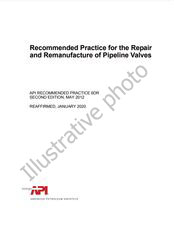We need your consent to use the individual data so that you can see information about your interests, among other things. Click "OK" to give your consent.

API PUBL 4713-ed.2002
Test Report: Fluidized Catalytic Cracking Unit at a Refinery (Site A); Characterization of Fine Particulate Emission Factors and Specification Profiles from Stationary Petroleum Industry Combustion Sources
Translate name
STANDARD published on 1.3.2002
The information about the standard:
Designation standards: API PUBL 4713-ed.2002
Publication date standards: 1.3.2002
SKU: NS-1139870
The number of pages: 128
Approximate weight : 415 g (0.91 lbs)
Country: American technical standard
Category: Technical standards API
Annotation of standard text API PUBL 4713-ed.2002 :
API PUBL 4713, 2002 Edition, March 2002 - Test Report: Fluidized Catalytic Cracking Unit at a Refinery (Site A); Characterization of Fine Particulate Emission Factors and Specification Profiles from Stationary Petroleum Industry Combustion Sources
OBJECTIVES: The specific objectives of this test were to:
Primary objectives
• Compare PM2.5 mass measured using an in-stack filter and iced impinge train (EPA Method 201A/202) and PM2.5 mass measured using a dilution tunnel;
• Develop emission factors and speciation profiles for organic aerosols and PM2.5 mass;
• Characterize sulfate (SO4=), nitrate (NO3-), ammonium (NH4+), chloride (Cl-) elemental carbon (EC) and organic carbon (OC) in particulate matter collected on filter media after stack gas dilution;
• Characterize semivolatile organic compounds (SVOC) in stack gas samples after dilution;
• Characterize key gaseous secondary particle precursors in stack gas samples: volatile organic compounds (VOC) with carbon number of 7 and above; sulfur dioxide (SO2); sulfur trioxide (SO3); ammonia (NH3); and oxides of nitrogen (NOX);
• Document the relevant process design characteristics and operating conditions during the test.
Secondary Objectives
• Characterize ions (SO4=, NO3-, NH4+ and Cl-), OC, and EC in particulate collected on filter media in stack gas sampling trains;
• Characterize the size distribution of solid and condensible particles at stack conditions.
We recommend:
Technical standards updating
Do you want to make sure you use only the valid technical standards?
We can offer you a solution which will provide you a monthly overview concerning the updating of standards which you use.
Would you like to know more? Look at this page.



 Cookies
Cookies
